- Effective ANC
- Good sound quality
- Excellent call quality
- Great battery life
- No sidetone for calls
- No aptX/aptX HD/LDAC codecs
Right now, Sony’s $350 WH-1000XM4 are the best noise-canceling headphones you can buy. We like them so much, they also top our lists of best wireless headphones and best headphones overall. Sony’s success hasn’t gone unnoticed by its competitors, which has led to several attempts to mimic the XM4, including JBL’s $300 Tour One.
The Tour One aren’t just a little like the XM4. From their size, weight, shape, and materials to their controls and features, it’s almost as if JBL used the XM4 as its blueprint for the Tour One and then figured out how to sell it for $50 less.
The question you’re probably asking yourself is, should I go ahead and buy the Tour One and save that $50, or did JBL cut too many features in its attempt to slide in under the XM4’s price? I think the Sony headphones are still the ones to buy, but JBL has still managed to make the Tour One worth your consideration thanks to a few things it does really well. Let’s get into it.
What’s in the box?
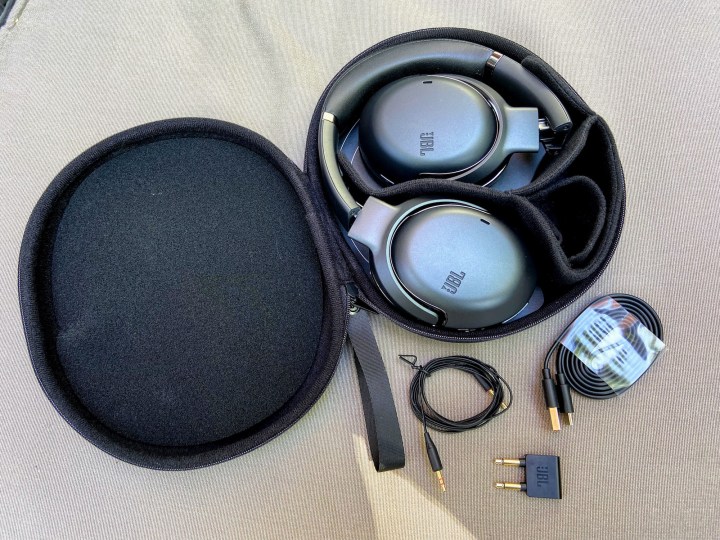
JBL still has a thing or two to learn about sustainable packaging. The Tour One box contains lots of foam padding and coated cardboard, making it tricky to recycle.
Open up the box and you’ll find the Tour One nestled in their own semi-hardshell, zippered carrying case. This is your first clue that JBL took its inspiration from Sony. Not only is the case almost exactly the same size and shape as the one Sony uses for both the WH-1000XM3 and XM4, but it also has the same mesh pocket sewn to one side, which can be used for small accessories or perhaps a credit card and ID if you took it to the gym.
Inside the case, the Tour One are folded into exactly the same position as the Sony cans and there’s a paper insert with a diagram to remind you how to insert the headphones so they fit, again, just like Sony does.
If you find Sony’s designs too conservative, the Tour One add just enough bling to avoid looking boring.
The similarities continue right down to the small compartment that houses the included accessories: A USB-A to USB-C charging cable, a 3.5mm to 2.5mm analog cable, and a double-prong flight adapter.
Unlike Sony, JBL’s charging cable is actually a usable length (40 inches versus Sony’s ludicrously short 9 inches). The USB-A side is reversible for guess-free usage — a nice touch.
Design
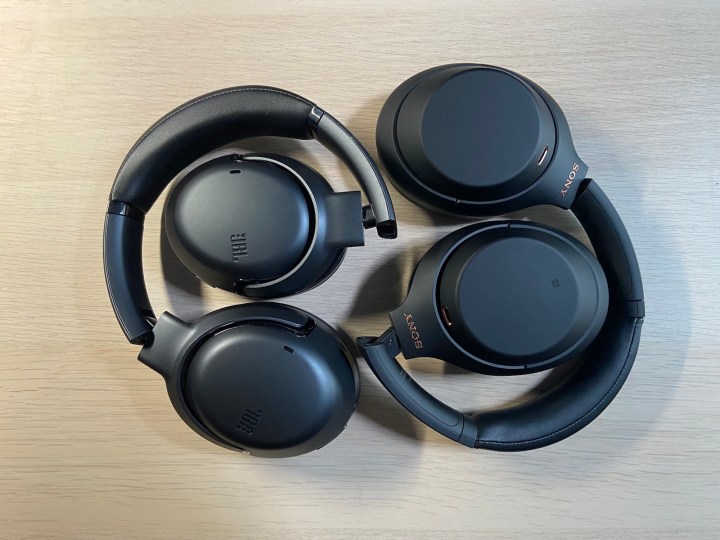
Given how closely the Tour One resemble the WH-1000XM4, it’s hard to quibble with their overall design. It’s a compact shape that keeps the earcups and headband close to your head, so you don’t look like you just walked off the set of a Daft Punk video.
The earcups smoothly pivot, fold, and articulate themselves to match the shape of your head. The headband is well-padded and the sliders move with a precise “notchiness” that is both easy to adjust and secure once adjusted.
The Tour One are still very light and very comfortable.
JBL has graced the Tour One with a slightly satin finish on the plastics and added some black chrome accents that give the cans a decidedly premium look. If you find Sony’s designs too conservative, the Tour One add just enough bling to avoid looking boring.
Controls-wise, JBL actually improves on Sony’s design. JBL keeps things simple by ditching Sony’s swipe gestures for a combination of simple taps on the right earcup for playback control and a dedicated set of buttons for volume. A combo power/Bluetooth pairing switch on the right earcup and a single multifunction button on the left earcup round out the Tour One’s controls.
Comfort, controls, and connections

Though not quite as light as the WH-1000XM4 (9.45 ounces vs. 8.95 ounces), the Tour One are still very light and very comfortable. There’s generous padding on the ear cushions and headband, and I was able to wear them for three hours continuously without any fatigue, even while wearing glasses. One thing that did start to bother me toward the end of that time was the depth of the earcups. My ears stick out quite a bit — maybe a little more than average — and their outer edges make contact with the inside lining. Eventually, that pressure point needed some relief.
If your ears are like mine, both the Sony WH-1000XM4 and Bose Noise Cancelling Headphones 700 offer deeper earcups.
The fold-flat hinges on the Tour One are great for when you want to wear them around your neck, and they fold the right way, meaning that the earcups point down, with the ear cushions against your collar bones. Sony does this too, but Bose makes the peculiar decision to rest the far-less cushy headband sliders against your clavicles.
Despite their comfy fit, the Tour One have a greater tendency to shift around on your head than either the Bose or the Sony. It’s not a deal-breaker by any means, but if you want a set of full-size cans for the gym as well as the office or airplane cabin, you should keep this in mind.
The Tour One’s controls are very easy to use. The single, double-, and triple-tap touches on the right earcup register every time (as long as you tap in the center) and I like having a power switch that instantly powers the headphones on. The Bose 700 power on instantly as well, but the Sony XM4s require more patience, with a press-and-hold gesture on the power button.
Using the JBL Headphones app provides some control customizations. Both the multifunction button as well as the tap-and-hold gesture on the touch panel can be set to control the active noise cancellation (ANC)/TalkThru modes or to trigger your voice assistant.
Bluetooth connectivity is excellent.
The auto-pause option works really well. Pulling the earcups away from your head instantly halts the tunes, then resumes them just as quickly when they are snapped back into place. You can disable the feature in the Headphones app if you want.
Bluetooth connectivity is excellent. Though not considered a class 1 Bluetooth device like the Beats Studio 3 headphones, I was still able to leave my phone at my desk and walk all the way to my garage (about 60 feet, one story, and several walls in terms of distance) and the signal stayed strong. You can also connect the Tour One to two Bluetooth devices simultaneously, though on one occasion this created a static sound that was resolved by disconnecting my phone and reconnecting it.
Sound quality

Out of the box, the Tour One have a relatively neutral EQ. There’s nice definition across frequencies, and excellent clarity in the upper midranges and highs. Bass response is snappy and not overbearing. You can tell that JBL has tuned these cans to be as genre-agnostic as possible, which stands in contrast to headphones that lean toward the low-end.
When compared to the Sony XM4, the Tour One don’t exhibit as much warmth or as wide a soundstage, but the difference isn’t huge. Curiously, just like JBL’s other flagship wireless cans, the Club One, the Tour One aren’t equipped with any high-quality Bluetooth codecs like aptX, aptX HD, or LDAC. So despite being capable of reproducing frequencies from 20Hz to 40kHz (and thus being considered hi-res audio compatible), you’ll never come close to experiencing this when using the headphones wirelessly. The XM4 give you LDAC, which won’t do much for iPhone owners, but will provide better sound quality for those with Android phones.
Listening via Bluetooth lets you appreciate the song’s bones, but going wired lets you hear its soul.
And that’s a shame because when you plug the Tour One into a digital-to-analog converter (DAC) with the included analog cable, they deliver much better depth and resonance.
One of my favorite test tracks is Billie Eilish’s Bad Guy. Not only does it have incredibly deep bass, but it also layers Eilish’s whispery voice on top, creating a torture chamber for audio devices. It’s also a deceptively complex recording. Listening via Bluetooth lets you appreciate the song’s bones, but going wired lets you hear its soul. Suddenly, Eilish isn’t just whispering her way through the lyrics, she’s whispering directly into your ears — it’s a goosebumps-inducing ASMR-level experience.
I don’t want to dump on the wireless performance too much as it’s actually very good, and I really like the fact you can access EQ presets and manual EQ adjustments within the app. Doing so can radically alter the Tour One’s sound signature, so if you’re not a fan of the so-called flat EQ, you don’t have to put up with it.
Noise cancellation and transparency
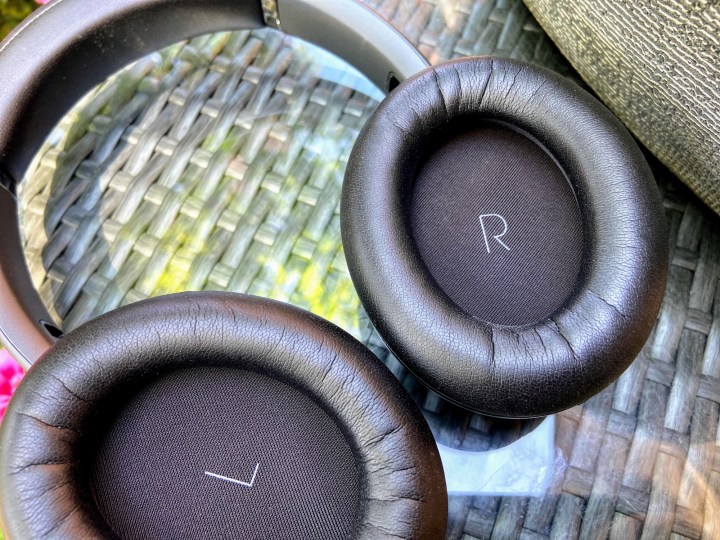
The Tour One does a decent job of canceling external sounds, but its performance can be a bit uneven. Unlike the Sony XM4 and Bose 700, the Tour One seems to struggle to create a nice, even cancellation effect. I have a fan under my desk that produces both consistent sound and consistent wind. JBL’s ANC blocks it well enough but it can’t quite decide which of the fan’s frequencies to block, so you can actually hear it hunting around and the result can be a bit unpleasant.
This mostly happens when you use JBL’s True Adaptive ANC mode, which attempts to respond to your listening conditions in real time. Turning that feature off helped a lot. In fairness, my desk fan situation is a bit of an anomaly — I wasn’t aware of the problem at all at other times — but both the Sony XM4 and Bose 700 handled it flawlessly, with the Bose being easily the best of the three.
The Silent Now mode is handy for when you just want quiet: It activates ANC but keeps Bluetooth communication turned off, saving the battery for when you need it.
In short, I’ve never tested a set of wireless headphones with better call quality than the Tour One.
JBL gives you two distinct transparency modes to choose from, and both have their advantages. For better general awareness of your surroundings, you can pick Ambient Aware — which lets in a lot of external sounds without altering your music. Or, if you need to actually speak to someone, you can engage TalkThru mode, which is just like Ambient Aware, but it also drops the volume of your audio to the point where it’s barely detectable.
Strangely, you can flip back and forth between full ANC mode and TalkThru by double-clicking the multifunction button, but if you want to switch between ANC and Ambient Aware, you’re forced to switch between three modes: ANC >, Ambient Aware >, Ambient Aware off > ANC.
Call quality
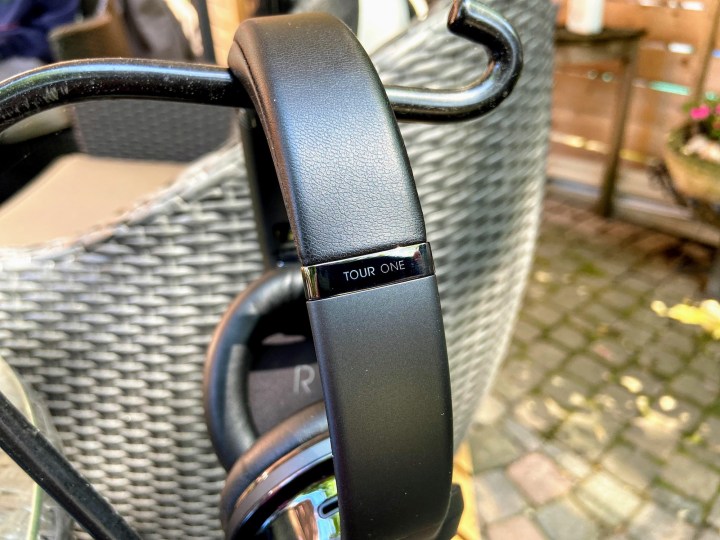
So far, most of the JBL Tour One’s qualities put them more or less where you’d expect in comparing them to the Sony WH-1000XM4 and Bose Noise Cancelling Headphones 700. But one area where the Tour One blow these other headphones away is their call quality.
I was able to walk down a very busy street, with varying kinds of traffic noise including loud buses and some construction machinery, and yet when you listen to the recording I made, you’d swear I was sitting in a quiet park by myself — that’s how little external noise was picked up by the Tour One’s mics.
Not only is your voice uninterrupted by these competing sounds, but it sounds really good too. The Tour One capture and preserve your voice’s deeper tones, the ones that give it depth and resonance, which stands in sharp contrast to most other headphones and earbuds.
In short, I’ve never tested a set of wireless headphones with better call quality than the Tour One.
The only caveat here is that JBL has dedicated all of the Tour One’s mics to canceling noise and optimizing voice quality, which means there’s no sidetone, and no way to stay in Ambient Aware mode or TalkThru mode while on a call. So while your callers will love the way you sound, you won’t be able to hear your own voice as clearly.
Battery life
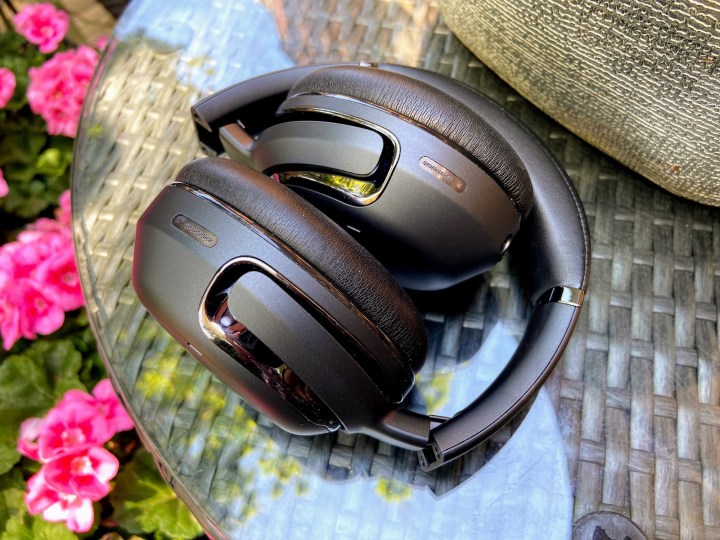
JBL claims you’ll get 50 hours of battery life from the Tour One if you disable ANC, and about half that amount if you keep it on. I did not run them for a full charge/discharge cycle, but after about 10 hours of playing music at 50% volume with ANC on, the JBL Headphones app gave me a battery reading of 55% which seems pretty close to JBL’s claims.
These are great numbers. Better than Sony, better than Bose, and even a tiny bit better than the Marshall Monitor ANC II, our previous best premium cans for battery life.
It takes two hours to charge them fully from empty, but you can get three hours of play time from a 10-minute quick charge.
Extras
JBL’s Tour series which includes the Tour One headphones and the Tour Pro+ true wireless earbuds, are one of the few on the market that offer hands-free access to your choice of Google Assistant or Amazon Alexa.
Once you pick your assistant, you can say “Hey Google,” or “Alexa” and then ask for whatever you need — including controlling playback, call answer, and volume. Using this option frees up one of the Multifunction button’s gestures, giving you more control over other headphone functions.
I only tested Amazon’s Alexa, but it worked flawlessly. JBL hasn’t indicated if using hands-free access reduces battery life (and I wasn’t able to determine if it does), but it’s highly likely that it will.
You also get JBL’s My Alarm feature, which lets you select from a variety of soothing sounds, combined with a customizable sleep timer.
Our take
For those who want a premium set of noise-canceling headphones, the JBL Tour One offer an excellent (and cheaper) alternative to Sony and Bose, with very few sacrifices made for their more affordable price. And they’re killer for phone calls.
Is there a better alternative?
Yes, overall, the Sony WH-1000XM4 are still a better set of noise-canceling headphones, beating the Tour One in sound quality, ANC, comfort, and wireless hi-res audio. But unless you can find them on sale, they’re a good bit more expensive than the JBL Tour One. If you don’t mind the trade-offs, I see no reason not to buy the Tour One instead of the Sonys.
How long will they last?
From what I can tell, the build quality and materials on the Tour One are both excellent, and I suspect they will fare about the same as models from Sony and Bose in terms of longevity. They may even have an edge thanks to their bigger battery life, as batteries are usually the first part to degrade in a set of wireless headphones.
JBL backs the Tour One with a one-year warranty.
Should you buy them?
Yes. They’re a solid option for those looking for comfortable noise-canceling headphones with good sound quality, great battery life, and excellent call quality












